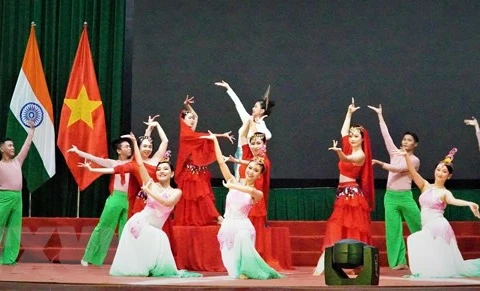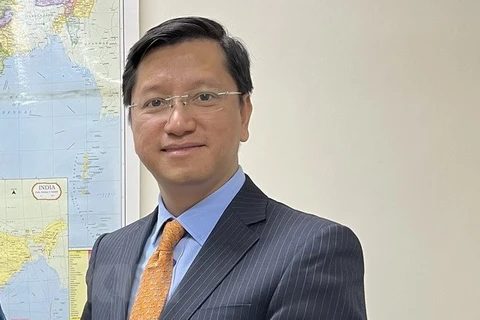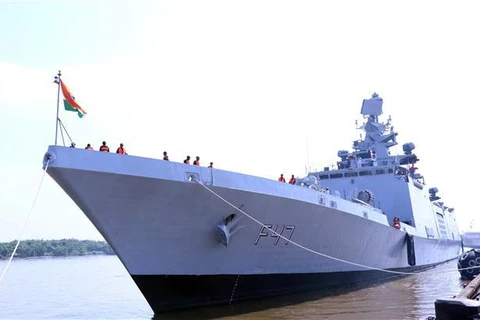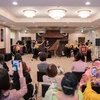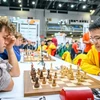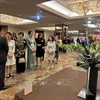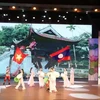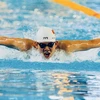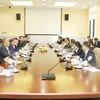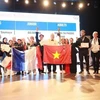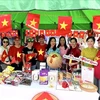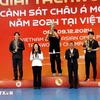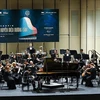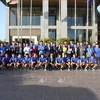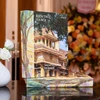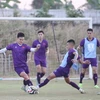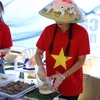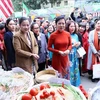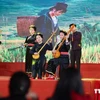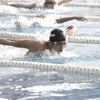Hanoi (VNS/VNA) - Popular artists from India are performing classical dances in Hanoi and some central provinces till December 9.
The show series, which is co-hosted by the Indian Embassy and the Vietnam Ministry of Culture, Sports and Tourism, aims to celebrate the 50th anniversary of diplomatic ties between the two countries.
The presentation was choreographed by the great scholar and seasoned art administrator Dr Sonal Mansingh, a Member of Parliament of the Upper House of the Indian Parliament (Rajya Sabha).
The performance comprised three main themes; Ardha-nareeshwar, a concept that represents the synthesis of masculine and feminine energies of the universe and illustrates how Parvati, the female principal of God is inseparable from Shiva- the male principal of God; Dashavatara, a description of the evolutionary cycle from the Indic lore which shows 10 incarnations of Lord Vishnu and Vande Mataram, a salutation to the Motherland of India through an evocative poem written by patriot-poet Mr Bankim Chandra Chattopadhyay in early 20th century.
“We are celebrating our 50th year of the diplomatic relationship,” Subhash P Gupta, Deputy Chief of Mission in the Indian Embassy to Vietnam told Vietnam News. “So this dance performance is actually important. This connects our people to people and our cultures.”
“This is a symbolic expression of love and affection between these our two societies,” he added. “We exchange our practices and enriched appetite and this is a mean to convey our good message to our Vietnamese respect.”
Dr Mansingh has been unique among dancers by mastering multiple Indian classical dance forms from different parts of India such as Bharatanatyam, Odissi and Chhau. She is a great scholar and seasoned art administrator who has performed, lectured and conducted workshops in 90 countries around the world.
“Indian classical dance is unique in the world, which uses the whole body every part of the face, every finger, and which pertains to life in a huge beautiful perennial eternal weight,” she confirmed. “It teaches us about love, devotion, goodness and it also tells you what you should not do: you should not be arrogant, you should not be devious, you should not be jealous…so many things that we learn in the books of religion. It is a living dancing religion.”
This is her third visit to Vietnam. The first time in 1983, when Prime Minister Pham Van Dong came to see her performance and she was awarded a Friendship Medal; the second in 2012.
She has received various honours like the Padma Bhushan prize (1992) and Padma Vibhushan prize (2003) from the Indian President.
“The audience here is so wonderful, that’s why I come again,” she said.
Nguyen Hanh Lien, a Hanoian learner at Swami Vivekananda Culture Centre in Hanoi, praised the show in Hanoi on December 1.
“I could feel the Indian spirit and culture in the show,” she said.
Lien said she has taken a course on Kuchipudi, an Indian traditional dance at the centre. She knows that Indian classical dance has various branches, which educate people about love, gratefulness for their country and other good characteristics of Indian people.
“Indian and Vietnamese folk dances share various same features on music, rhythms and spirit of dancers sent in the dance,” she noted. “All the dances contain the beauty in the art and the goodness of each people.”
The performance was an effort to bring Indian culture and art forms to the audience in Vietnam and is sponsored and facilitated by the Indian Council for Cultural Relations, New Delhi.
Besides the show in Hanoi on December 1, the repertoire group will also visit the provinces of Binh Dinh, Phu Yen, Ninh Thuan and Tay Ninh from December 4-9 to perform./.
The show series, which is co-hosted by the Indian Embassy and the Vietnam Ministry of Culture, Sports and Tourism, aims to celebrate the 50th anniversary of diplomatic ties between the two countries.
The presentation was choreographed by the great scholar and seasoned art administrator Dr Sonal Mansingh, a Member of Parliament of the Upper House of the Indian Parliament (Rajya Sabha).
The performance comprised three main themes; Ardha-nareeshwar, a concept that represents the synthesis of masculine and feminine energies of the universe and illustrates how Parvati, the female principal of God is inseparable from Shiva- the male principal of God; Dashavatara, a description of the evolutionary cycle from the Indic lore which shows 10 incarnations of Lord Vishnu and Vande Mataram, a salutation to the Motherland of India through an evocative poem written by patriot-poet Mr Bankim Chandra Chattopadhyay in early 20th century.
“We are celebrating our 50th year of the diplomatic relationship,” Subhash P Gupta, Deputy Chief of Mission in the Indian Embassy to Vietnam told Vietnam News. “So this dance performance is actually important. This connects our people to people and our cultures.”
“This is a symbolic expression of love and affection between these our two societies,” he added. “We exchange our practices and enriched appetite and this is a mean to convey our good message to our Vietnamese respect.”
Dr Mansingh has been unique among dancers by mastering multiple Indian classical dance forms from different parts of India such as Bharatanatyam, Odissi and Chhau. She is a great scholar and seasoned art administrator who has performed, lectured and conducted workshops in 90 countries around the world.
“Indian classical dance is unique in the world, which uses the whole body every part of the face, every finger, and which pertains to life in a huge beautiful perennial eternal weight,” she confirmed. “It teaches us about love, devotion, goodness and it also tells you what you should not do: you should not be arrogant, you should not be devious, you should not be jealous…so many things that we learn in the books of religion. It is a living dancing religion.”
This is her third visit to Vietnam. The first time in 1983, when Prime Minister Pham Van Dong came to see her performance and she was awarded a Friendship Medal; the second in 2012.
She has received various honours like the Padma Bhushan prize (1992) and Padma Vibhushan prize (2003) from the Indian President.
“The audience here is so wonderful, that’s why I come again,” she said.
Nguyen Hanh Lien, a Hanoian learner at Swami Vivekananda Culture Centre in Hanoi, praised the show in Hanoi on December 1.
“I could feel the Indian spirit and culture in the show,” she said.
Lien said she has taken a course on Kuchipudi, an Indian traditional dance at the centre. She knows that Indian classical dance has various branches, which educate people about love, gratefulness for their country and other good characteristics of Indian people.
“Indian and Vietnamese folk dances share various same features on music, rhythms and spirit of dancers sent in the dance,” she noted. “All the dances contain the beauty in the art and the goodness of each people.”
The performance was an effort to bring Indian culture and art forms to the audience in Vietnam and is sponsored and facilitated by the Indian Council for Cultural Relations, New Delhi.
Besides the show in Hanoi on December 1, the repertoire group will also visit the provinces of Binh Dinh, Phu Yen, Ninh Thuan and Tay Ninh from December 4-9 to perform./.
VNA

